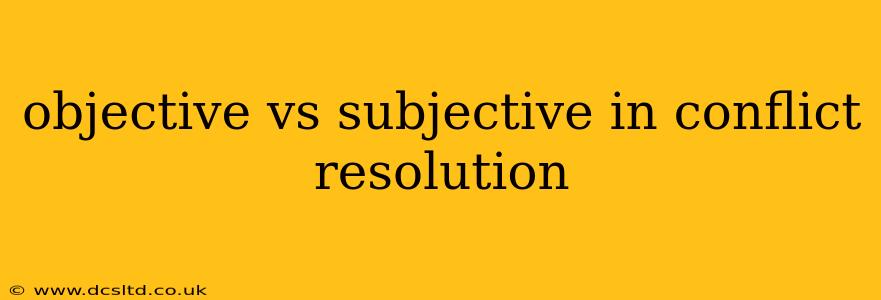Conflict is inevitable in any relationship, whether personal or professional. Successfully navigating these disagreements hinges on understanding the difference between objective and subjective perspectives, and how to leverage both for effective conflict resolution. This article will explore the nuances of objectivity and subjectivity in conflict, offering practical strategies to foster understanding and find mutually agreeable solutions.
What is Objective Information in Conflict Resolution?
Objective information refers to verifiable facts and data that are independent of personal feelings or opinions. In a conflict, this might include:
- Dates and times: When an event occurred, deadlines missed, or promises broken.
- Documents: Emails, contracts, or written agreements that provide evidence.
- Witness accounts: Statements from neutral third parties who observed the situation.
- Measurable outcomes: Sales figures, project completion rates, or quantifiable results.
Using objective data anchors the discussion in reality, reducing the emotional intensity and minimizing misunderstandings fueled by biased interpretations. For example, instead of saying "You always interrupt me," a more objective statement would be, "During our last three meetings, you interrupted me on five occasions."
What is Subjective Information in Conflict Resolution?
Subjective information, on the other hand, involves personal opinions, beliefs, feelings, and interpretations. These are crucial in conflict resolution because they reveal the emotional core of the disagreement. In conflict, subjective information might include:
- Emotions: Frustration, anger, sadness, fear, or disappointment.
- Perceptions: How each party views the situation, their motivations, and the other party's intentions.
- Values: Underlying beliefs and principles that influence behavior and reactions.
- Needs: Underlying unmet requirements that contribute to the conflict.
Understanding the subjective experiences of all parties involved is critical for empathy and finding a resolution that addresses everyone's emotional needs. Ignoring subjective feelings often escalates conflict, as it leaves unresolved emotional wounds.
How to Balance Objective and Subjective Information
Effective conflict resolution requires a delicate balance between objective and subjective information. Here's how to integrate both successfully:
- Acknowledge both perspectives: Validate the feelings and experiences of all involved parties, even if you don't agree with their interpretation of the facts. Active listening is crucial here.
- Focus on shared goals: Remind everyone of the common objectives you're striving toward. This helps shift the focus from blame to collaboration.
- Separate facts from feelings: Clearly distinguish between objective data and subjective interpretations. This clarity helps prevent emotional arguments from overshadowing the core issues.
- Seek common ground: Look for areas of agreement, even if they are small. These points of convergence can be built upon to reach a wider resolution.
- Find objective solutions: Based on the shared understanding of the situation, brainstorm solutions that address both the objective facts and the subjective emotional needs.
How Can I Separate Objective and Subjective Information During a Conflict?
This is a crucial skill in conflict resolution. One effective technique is to use "I" statements. For example, instead of saying "You always make me feel bad," try "I feel hurt when I experience X." This clearly separates your subjective feeling ("hurt") from the objective observation (X). Encouraging others to utilize similar language can greatly improve the clarity and focus of the discussion.
What Are Some Examples of Objective and Subjective Statements in Conflict Resolution?
Objective: "The deadline for the project was November 15th, and the report was submitted on November 22nd."
Subjective: "I felt overwhelmed and stressed because the project took longer than expected."
How Do I Handle Subjective Information That Seems Inaccurate?
Even if subjective information seems inaccurate or exaggerated, acknowledging the underlying feelings is important. You might say, "I understand you feel frustrated, and while I don't see the situation exactly the same way, I want to address your concerns." Focus on understanding their perspective, even if you don't share it.
Conclusion
Successfully navigating conflict necessitates a nuanced understanding of both objective and subjective information. By acknowledging the facts while validating the emotional experiences of all involved, you can foster a collaborative environment that leads to mutually acceptable resolutions. Remember, effective conflict resolution is not about winning or losing, but about building stronger relationships through mutual understanding and compromise.
